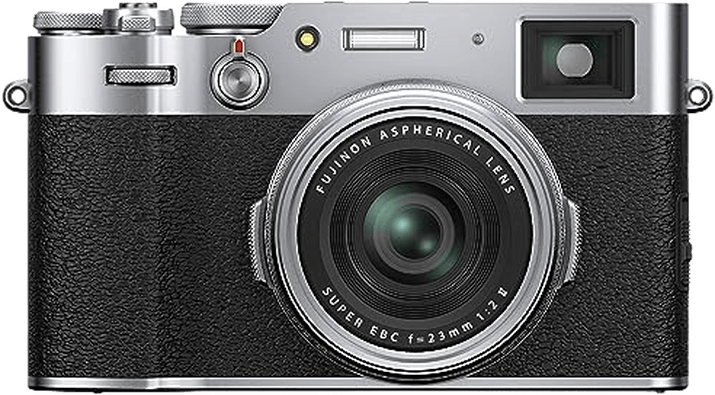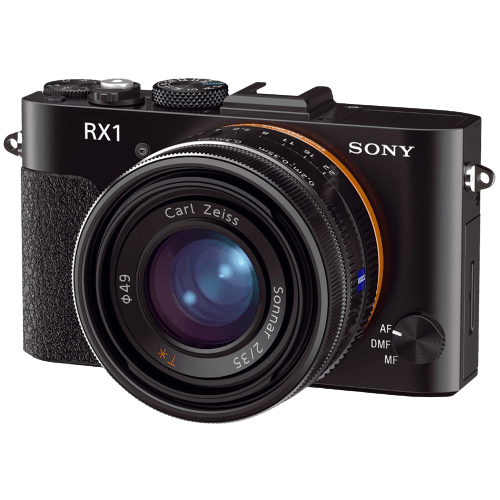Fujifilm X100V vs Sony Cyber-shot DSC-RX1 Comparison
Fujifilm X100V

Sony Cyber-shot DSC-RX1

The Fujifilm X100V outperforms the Sony Cyber-shot DSC-RX1 with a score of 69/100 versus 57/100. Both cameras share similarities, such as being lightweight (X100V: 478g, RX1: 482g) and having similar dimensions (X100V: 128x75x53mm, RX1: 113x65x70mm).
The X100V, a mirrorless camera, has advantages over the RX1, a compact camera. Released in 2020, the X100V is more recent and has a lower launch price ($1,399) compared to the RX1’s 2012 release and $2,800 launch price.
Despite its lower score, the RX1 still has merits. Its compact size makes it easier to carry around for casual photography. However, the X100V’s higher score, lower price, and newer technology make it the more favorable choice.
Fujifilm X100V vs Sony Cyber-shot DSC-RX1 Overview and Optics
The Sony Cyber-shot DSC-RX1 wins in the optics comparison with a score of 67/100, just one point ahead of the Fujifilm X100V at 66/100. Both cameras have some similarities in their specs, including a CMOS sensor, fixed lens mount, and lack of image stabilization.
The Fujifilm X100V sports a 26-megapixel sensor, higher shooting speed of 11, and an X-Processor 4. These features give it an edge in capturing detailed images at a faster rate. However, it is important to note that DXOMARK does not score Fujifilm cameras, so we cannot directly compare the sensor quality with the Sony model.
On the other hand, the Sony Cyber-shot DSC-RX1 has a 24.3-megapixel sensor, slower shooting speed of 5, and a Bionz processor. Despite having a lower megapixel count and shooting speed, this camera boasts a full-frame sensor, which contributes to its higher score. The full-frame sensor allows for better low-light performance and a shallower depth of field. Additionally, the RX1 has a DXOMARK score of 93 for its sensor, indicating high-quality performance.
In terms of optics, the Sony Cyber-shot DSC-RX1 has the advantage with its full-frame sensor and a higher DXOMARK score. While the Fujifilm X100V offers more megapixels and a faster shooting speed, these factors are not enough to surpass the RX1’s overall optical performance.
Thus, the Sony Cyber-shot DSC-RX1 is the better choice for those prioritizing optics in their camera purchase, while the Fujifilm X100V may be more suitable for those who value faster shooting speeds and higher megapixels.
Fujifilm X100V vs Sony Cyber-shot DSC-RX1 Video Performance
The Fujifilm X100V emerges as the winner in the video capabilities comparison with a score of 91/100, while the Sony Cyber-shot DSC-RX1 trails behind with a score of 56/100. Both cameras share certain video specifications, including the ability to record video and adjust video frame rates. However, the X100V outperforms the RX1 in specific aspects, making it the superior choice for video recording.
The X100V boasts a maximum video resolution of 4K and dimensions of 4096 x 2160, which is significantly better than the RX1’s Full HD resolution and 1920 x 1080 dimensions. This difference means that the X100V can produce higher quality videos with more detail and clarity. Additionally, the X100V has a maximum video frame rate of 120fps, double the RX1’s 60fps. This higher frame rate allows for smoother video playback and better slow-motion effects.
Another advantage the X100V holds over the RX1 is the built-in time-lapse functionality. This feature enables users to create stunning time-lapse videos without the need for additional software or equipment. The RX1 lacks this functionality, making it less versatile in comparison.
Despite its lower score, the Sony Cyber-shot DSC-RX1 does offer Full HD video recording and a respectable maximum frame rate of 60fps. These features may be sufficient for casual users or those who prioritize still photography over video capabilities.
Ultimately, the Fujifilm X100V is the superior choice for video capabilities due to its higher resolution, greater frame rate, and built-in time-lapse functionality. While the Sony RX1 may satisfy some users’ video needs, the X100V’s advantages make it the better option for those seeking a camera with strong video performance.
Fujifilm X100V vs Sony Cyber-shot DSC-RX1 Features and Benefits
The Fujifilm X100V outperforms the Sony Cyber-shot DSC-RX1 in features, scoring 85/100 compared to the Sony’s 44/100. Both cameras share some specifications, such as a 3-inch screen size and the lack of GPS. However, the X100V boasts several advantages over the DSC-RX1.
The X100V has a higher screen resolution of 1,620,000 dots, compared to the DSC-RX1’s 1,229,000 dots, resulting in a clearer and sharper display. Additionally, the X100V features a touchscreen, allowing for more intuitive control and easier navigation through settings. The camera also has Wi-Fi and Bluetooth capabilities, enabling quick and straightforward sharing of photos and remote control functionality.
On the other hand, the Sony Cyber-shot DSC-RX1 has fewer advantages. Both cameras have flip screens, which is useful for composing shots from various angles. The DSC-RX1, however, lacks a touchscreen, Wi-Fi, and Bluetooth, limiting its connectivity and ease of use compared to the X100V.
Considering the significant difference in feature scores and the various advantages the Fujifilm X100V offers over the Sony Cyber-shot DSC-RX1, it is evident that the X100V is the superior camera in terms of features. The higher screen resolution, touchscreen, and connectivity options make the X100V more versatile and user-friendly. While the DSC-RX1 shares some specifications with the X100V, it falls behind in key areas, making it a less competitive option for those looking to invest in a high-quality camera with advanced features.
Fujifilm X100V vs Sony Cyber-shot DSC-RX1 Storage and Battery
The Fujifilm X100V outperforms the Sony Cyber-shot DSC-RX1 in storage and battery, scoring 37/100 compared to 16/100. Both cameras have one memory card slot and accept SD, SDHC, and SDXC memory cards. However, the Sony RX1 also supports Memory Stick Pro Duo and Pro-HG Duo cards.
The X100V has a longer battery life, providing 420 shots per charge, while the RX1 only offers 270 shots. Additionally, the Fujifilm X100V uses the NP-W126S battery and supports USB charging, making it more convenient for users. On the other hand, the Sony RX1 uses the NP-BX1 battery and lacks USB charging capabilities.
Considering these factors, the Fujifilm X100V proves to be the better choice for storage and battery performance, while the Sony RX1 offers slightly more memory card compatibility but falls short in battery life and charging options.
Fujifilm X100V vs Sony Cyber-shot DSC-RX1 – Our Verdict
Are you still undecided about which camera is right for you? Have a look at these popular comparisons that feature the Fujifilm X100V or the Sony Cyber-shot DSC-RX1:

